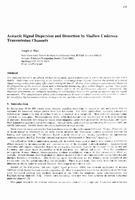| dc.contributor.author | Rice, Joseph A. | |
| dc.date.accessioned | 2018-10-11T14:08:20Z | |
| dc.date.available | 2018-10-11T14:08:20Z | |
| dc.date.issued | 1997 | |
| dc.identifier | 11497 | |
| dc.identifier.govdoc | CP-45 | |
| dc.identifier.uri | http://hdl.handle.net/20.500.12489/455 | |
| dc.description.abstract | The undersea littoral is an adverse medium for acoustic signal transmission to horizontal ranges of many water depths. Reflections and scattering in the bounded, nonhomogeneous channel disperse the arrivaj of received signal energy with a prolonging effect called multipath spread. Motion of the reflectors and scatterers disperses the frequencies of the received signal with a bandwidth broadening effect called Doppler spread. This paper examines the oceanographic causes and acoustic effects of the doubly-spread channel. Dispersion and distortion phenomena are evaluated according to relationships between the spread parameters and the signal parameters. This categorization, along with considerations of received signal-to-noise ratio, provides a context for identifying digital communications strategies for the shallow-water undersea acoustic channel. | |
| dc.format | 8 p. : ill. ; digital, PDF file | |
| dc.language | English | |
| dc.publisher | NATO. SACLANTCEN | |
| dc.source | In: High Frequency Seafloor Acoustics (SACLANTCEN Conference Proceedings CP-45), 1997, pp. 435-442 | |
| dc.subject | Acoustic propagation | |
| dc.subject | Transmission loss | |
| dc.subject | Shallow water | |
| dc.subject | Acoustic scattering | |
| dc.subject | Acoustic reflection loss | |
| dc.title | Acoustic signal dispersion and distortion by shallow undersea transmission channels | |
| dc.type | Papers and Articles | |
| dc.type | Conference Proceedings (CP) | |
